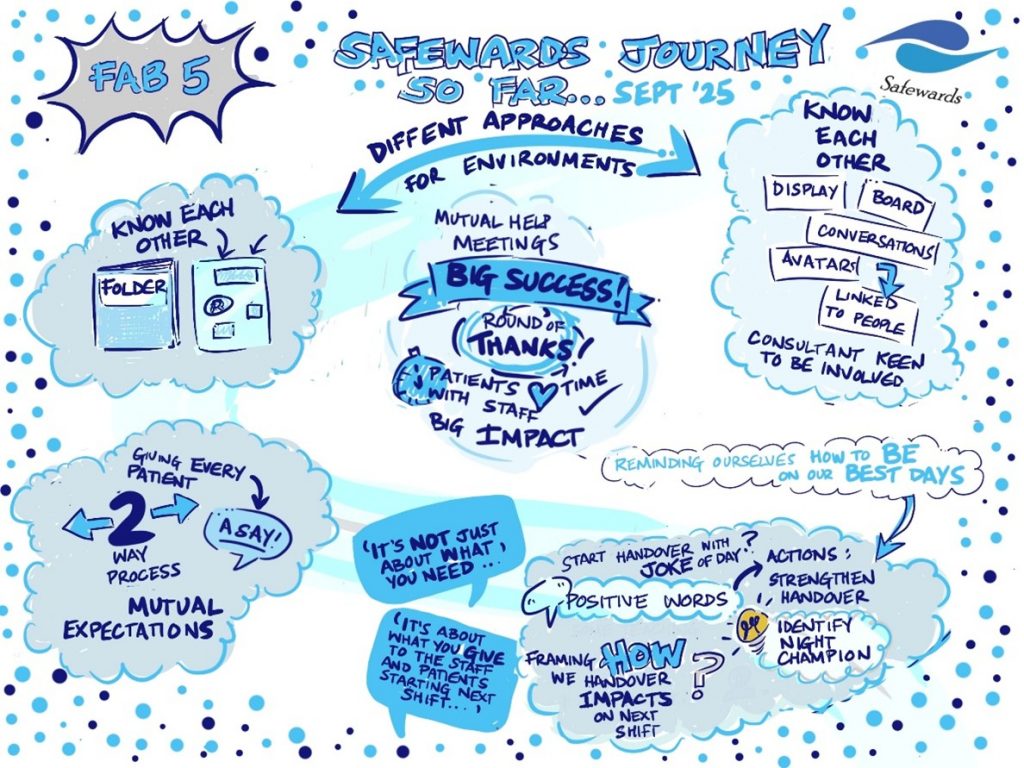Using interventions to empower the patient voice: The Safewards Approach
By Lisa Edwards, Senior Improvement Manager | With illustrations by Liz Tucker, Improvement Manager
For those working in mental health across Wales — on inpatient wards, in crisis teams, or community services — safety isn’t an abstract idea. It’s the feeling in the room. It’s the tension felt when someone’s distress is becoming overwhelming… or the relief felt when this has safely dissipated. It’s how we speak, listen, and respond, moment to moment.
Safewards is an evidence-based(1) initiative from King’s College London which recognises the pressures faced on mental health wards, offering a simple, structured approach to reducing conflict and containment through everyday relational practice. Rather than sweeping systemic overhaul, Safewards gently offers a series of ten small, human interventions — many of which staff are already doing intuitively.
The 10 Safewards Interventions

Across Wales while we face familiar challenges such as rising demand, workforce shortages, and increasing complex needs we’re also building on foundations of recovery-oriented practice, compassionate teamwork, and community-rooted care. Safewards doesn’t ask us to do more with less — it asks us to do what works, with intention.
Research shows that wards adopting Safewards have seen measurable reductions in conflict and containment:
- Up to twenty-three per cent fewer physical interventions
- Forty-two per cent reduction in prone restraint
- Improved staff–patient relationships and ward culture
The Safewards model promotes small, patient-centred changes which recognise the needs of each setting and its community; for example, one ward may record discharge messages in a book, another on a notice board or graffiti wall. Across Wales the five wards piloting Safewards have begun to embed interventions meaningfully to meet their patients’ needs while being manageable for staff teams.

Safewards – Discharge Messages
During a visit to one of the Safewards, I saw how the implementation of Safewards was progressing. A walk around the ward showed the immediate impact of their interventions.
In the centre of the ward, on a large table, was a discharge message book. The ward had chosen to use a book to allow patients to write as much as they wished, and to prevent messages being lost or damaged on a wall display.
Two patients were sitting at the table. One of them said she had just written a message and gave her permission to read it. Reading the words highlighted the thoughtfulness and time invested in her words.
The first thing that came to mind — and which I shared with her — was how beautifully written it was.

The author of this discharge message replied; “Coming into a mental health ward was one of the scariest times of my life. The ward has helped me so much. I feel the most positive I’ve ever been, and I wanted to share that with new patients coming in. I would have really benefitted from reading a message like this when I was first admitted.”
In a short space of time the book has become valued by patients and staff, with thank-you cards and messages included in the pages. A discharge book is just one way of giving value to positive and helpful messages written by patients as they leave to provide hope and reassurance to others as they arrive.
In the first quarter of a two-year pilot, Safewards is already having an impact in busy wards; staff are already believing that Safewards contributes to their ward ‘becoming a lovely place to work’. Starting a shift with a joke or quote of the day as part of the ‘Positive Words’ intervention can give everyone the opportunity to be in a positive mind space and remember how to be on our best days. Having a mutual expectation meeting or including this as part of a weekly welcome meeting can help everyone to understand what is expected of them – whether it’s patients talking to staff or staff sharing the ward routines, what matters most is time spent together.
Conclusion
The message is clear: safety is not just a policy — it is a practice, a presence, and a promise. Safewards reminds us that meaningful change does not always require grand gestures; it begins with small, intentional acts of care. Across Wales, we can lead by example, embedding these interventions into the fabric of our wards and teams. Let us commit to making every interaction count. Whether you are a psychiatrist, nurse, support worker, manager, or peer, your voice and actions shape the culture of care. Join us in championing Safewards — not just as a model, but as our daily practice. Together, we can create ‘Safewards’ for everyone.
